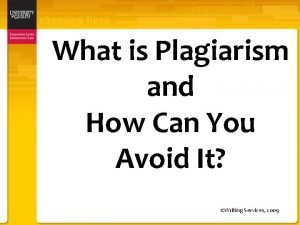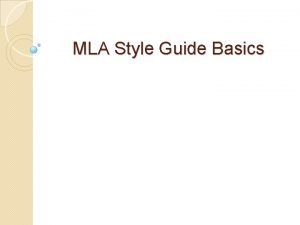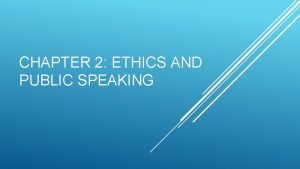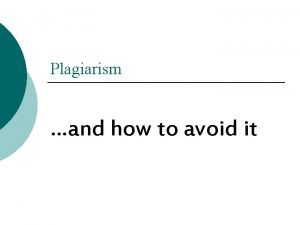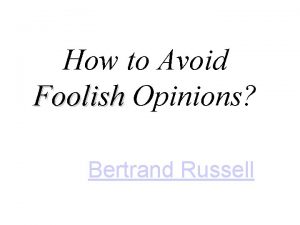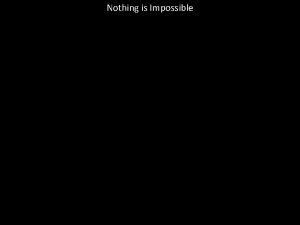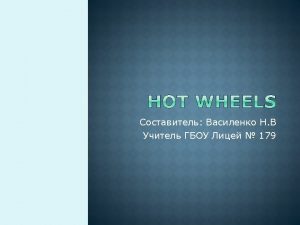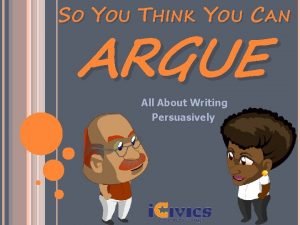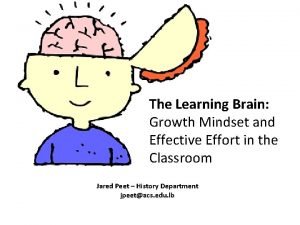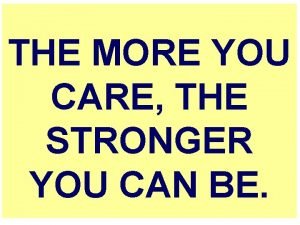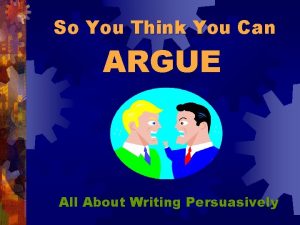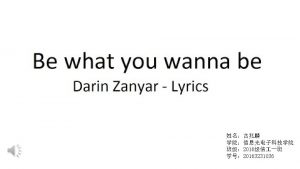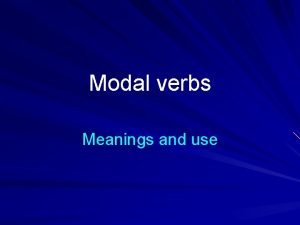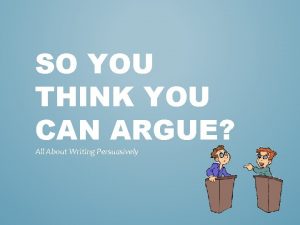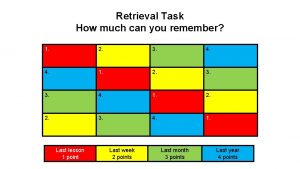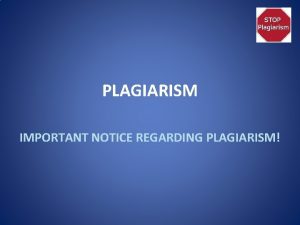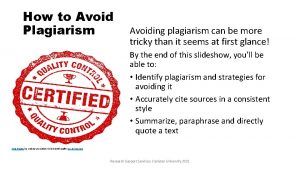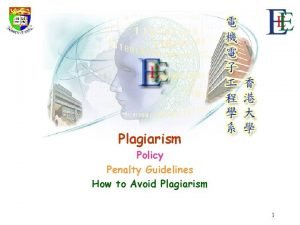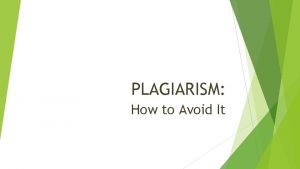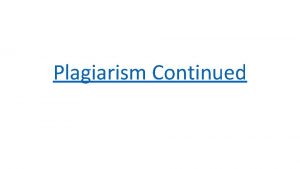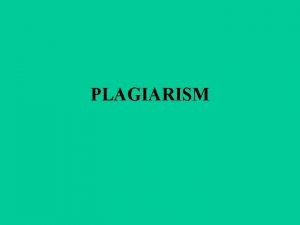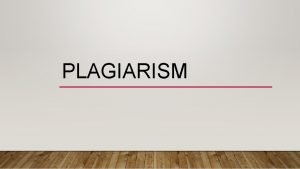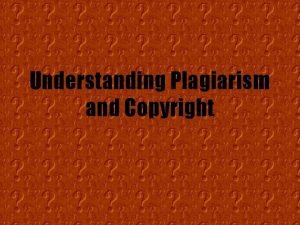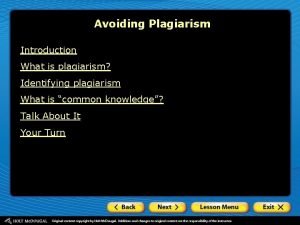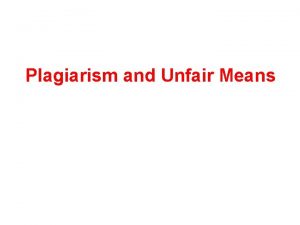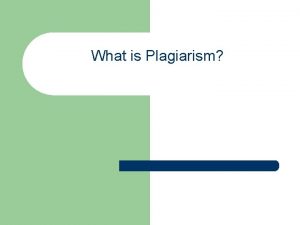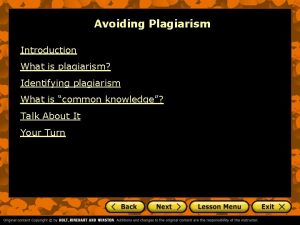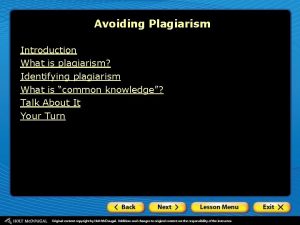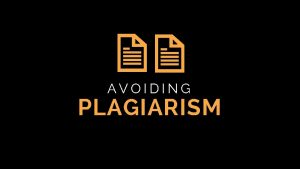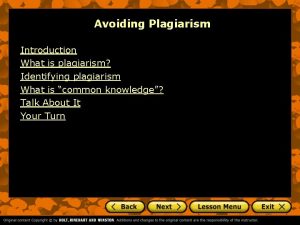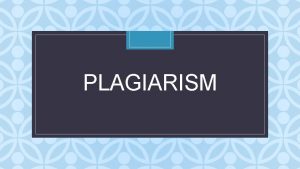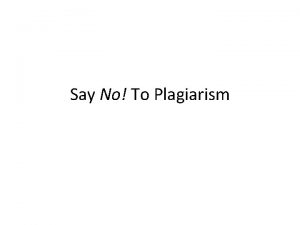Plagiarism What is it How can you avoid






























- Slides: 30

Plagiarism: What is it? How can you avoid it? What are the consequences? Created by: Ms. Henry Mrs. Glynn

Vocabulary associated with this lesson: o o o Plagiarism: claiming someone else’s work or ideas as your own. Original source: the source from which you quote or paraphrase. This can be a book, article, website, database article, interview, television show, song, documentary, movie, performance, work of art, map, radio program, lecture, legal source, government publication, pamphlet, personal letter, etc. Paraphrase: a restatement (in your own words and style) of a passage found in an original source. Changing two words in a ten word sentence is not paraphrasing. Direct quotation: someone’s exact words, phrases, or sentences used in your text. Such a quotation should preserve the original author’s intent. In-text citation (internal citation): directions for your reader for finding the original source in your list of works cited. This usually takes the form of the author’s last name and page number in parentheses. Works cited: your list of each source used in your project and its publication information. This enables your reader to find your original sources.

What is plagiarism? o copying another student’s paper, answers or homework o passing off another person’s ideas as your own o failing to cite quotations and borrowed ideas o failing to put paraphrases and summaries into your own words o failing to enclose someone else’s language or words in quotation marks o incorrectly citing

Using other people’s ideas is not plagiarism. o You are supposed to build upon others’ research/ideas. You should use the ideas of others to come to your own conclusions, but you must give proper credit.

How should you cite? o Generally, MLA (Modern Language Association) style is used for humanities, and APA (American Psychological Association) style is used for psychology and other social sciences. In addition, Chicago style has been used in history and some humanities classes; check with your instructor for which style he/she prefers. o For MLA style, the general rule is to place the author’s last name and the page number (for a print source) of the original text in parentheses after the quotation or paraphrase. For example (Smith 23). This short citation will enable your reader to find your full citation on the list of works cited at the end of your paper or assignment.

What should you cite? o information from books, articles, websites, interviews, etc. from which you quote or paraphrase It is essential that the United States government stand strong in its fight against drug use because “[i]t is during a period of drug permissiveness and weak punitive sanctions that a dramatic rise in crime and violence swept across America” (Peterson 32). We must learn from history and not make the same mistake twice. This is a direct quotation from page 32 of a chapter by Robert E. Peterson in a book of essays by various authors which discusses the problems with drugs. The i in the word “it” in the quotation is in brackets because the author of the paper changed a capital I to lower case to fit in his/her sentence. (You can also use brackets if you need to alter a phrase within the quotation in order to make it fit in grammatically with your sentence or in order to clarify what you are saying. )

The corresponding works cited entry would look like this: Peterson, Robert E. “Law Enforcement in Winning the War on Drugs. ” The War on Drugs: Opposing Viewpoints, edited by Stephen Thompson, Greenhaven Press, Inc. , 1990, pp. 28 -33. Notice how the entry is double-spaced with the second line (and each line thereafter) indented.

Here is another example, one you might find in a paper written for a social studies class. While some might disagree with him, Sidney Lens argues that “Roosevelt did save capitalism in the US (and Hitler saved it in Germany, as did Chamberlain in Britain, Daladier in France). FDR saved it but didn’t make it robust” (100). Notice how here the author’s last name is not included in the internal citation. This is because it is mentioned earlier in the sentence. The reader knows who the author of the quote is, so there is no need to reiterate it.

The corresponding works cited entry would look like this: Lens, Sidney. “Capitalism Will Die. ” Capitalism: Opposing Viewpoints, edited by Bruno Leone, Greenhaven Press, Inc. , 1978, pp. 98 -103.

Here is third example from an essay on Fahrenheit 451: While Montag at first assumes that he is content with who he is and how he lives his life, he begins to doubt himself after meeting Clarisse. When he comes home after she asks him if he is happy, he tries to convince himself that he is. “Of course I’m happy. What does she think? I’m not? he asked the quiet rooms. He stood looking up at the ventilator grille in the hall and suddenly remembered that something lay hidden behind the grille, something that seemed to peer down at him now. He moved his eyes quickly away” (10). Behind the grille lie the books Montag has secretly hidden, books that he has stolen at some point because deep within he is not whole and wants to discover more about life, thought, and emotion. It is Clarisse who acts as the catalyst that leads Montag to follow through on his curiosity and ultimately go against the regime.

Since this is the only source used in the essay, you do not need to include the author’s last name. You have presumably already stated his name in your introduction.

The corresponding works cited entry would look like this: Bradbury, Ray. Fahrenheit 451. Ballantine Books, 1991.

In this example the author of the paper makes reference to research done by Yates and Youniss; however, the information is found in a source by Friedland. Researchers have also come to understand that service-learning increases students’ feelings of responsibility in both the civic and social realm. Yates and Youniss’ research concludes that “community service offers the very best opportunity for adolescents to form a better connection between self and society because of their increased links to more meaningful social interaction” (Friedland 70). Students think more about how they play a part in the big picture of their immediate, state, national, and global communities. As a result, they are more likely to think about how to affect positive changes and will engage in efforts to achieve them.

The corresponding works cited entry, which happens to be from a professional journal, would look like this: Friedland, Stan. “Developing Hearts and Minds. ” Principal Leadership: High School Edition, 3. 8, 2003, pp. 70 -73.

What else should you cite? o summaries of someone else’s ideas While New York academicians ruled the American art world at the turn of the century, the painters of the time whose names we recognize today were unknown to Americans back then. The academicians followed the rules so they could gain membership in the National Academy, gain popularity, and sell their art, but doing so stifled their creativity. American painters like Whistler, Cassat, and Sargent who refused to sacrifice their creative freedom went abroad to study instead (Myron 56 -7).

This is a paraphrase of several paragraphs, or a summary of material. There are no direct quotations, so no quotation marks are used. Make sure that when you paraphrase you do not use the author’s language and sentence structure. To ensure that you use your own language and sentence structure, refrain from looking at the original source while writing your paraphrase.

The corresponding works cited entry would look like this: Myron, Robert, and Abner Sundell. Modern Art in America. Crowell-Collier Press, 1971.

You should also cite… o o opinions of others facts not widely known. You will not be penalized for citing a common fact, but not citing facts when a citation is needed is plagiarism and will result in negative consequences. When in doubt, cite your source. While some Americans think that since health authorities have warned against eating too much fat, it is best to eliminate fat completely from one’s diet, they are sorely mistaken. Our bodies need fat to function properly. Not all fats are created equal, though. While saturated fats, like those found in meats, will raise one’s cholesterol, monounsaturated fats, like those found in olive oil, and polyunsaturated fats, like those found in seed oils, can help reduce cholesterol levels (Rombauer 5 -6).

Although this paraphrase may include facts of which many people are aware, the information is not necessarily common knowledge, and therefore it must be cited.

The corresponding works cited entry would look like this: Rombauer, Irma S. , Marion Rombauer Becker, and Ethan Becker. The Joy of Cooking. Scribner, 1997.

Here is another example. This one is from an online database article: The bubonic plague is caused by Yersinia pestis, which is a bacteria which lives in rats and is transmitted to humans when a flea bites the rat and then the human (“Black Death Shaped the Human Genome”). This information could be looked up and found in many places, but you wouldn’t necessarily consider all of this information (in particular the part about Yersinia pestis) “common knowledge, ” so it must be cited.

The corresponding works cited entry would look like this: “Black Death Shaped Human Genome. ” Today's Science, Infobase Learning, 2015, Science Online, 18 Sept. 2016, http: //online. infobase. com/hrc/search/details/1009354? q=skin disorders. Note that in the citation doesn’t have an author. That is why the embedded citation is the title of the article.

Some additional items to cite: o visuals (maps, charts, pictures, etc. ) o help provided by a friend, tutor, instructor or parent

The preceding examples are from various sources on unrelated topics. However, if we were to create a works cited page that includes all of them, it would look like the next slide. Notice how everything is doublespaced.

Works Cited “Black Death Shaped Human Genome. ” Today's Science, Infobase Learning, 2015, Science Online, 18 Sept. 2016, online. infobase. com/hrc/search/details/1009354? q=skin disorders. Bradbury, Ray. Fahrenheit 451. New York: Ballantine Books, 1991. Friedland, Stan. “Developing Hearts and Minds. ” Principal Leadership: High School Edition 3. 8 (2003): pp. 70 -73. Lens, Sidney. “Capitalism Will Die. ” Capitalism: Opposing Viewpoints, edited Bruno Leone, Greenhaven Press, Inc. , 1978, pp. 98 -103. Myron, Robert, and Abner Sundell. Modern Art in America. Crowell-Collier Press, 1971. Peterson, Robert E. “Law Enforcement in Winning the War on Drugs. ” The War on Drugs: Opposing Viewpoints, edited by Stephen Thompson, Greenhaven Press, Inc. , 1990. 28 -33. Rombauer, Irma S. , Marion Rombauer Becker, and Ethan Becker. The Joy of Cooking. New York: Scribner, 1997.

How do you find the proper format for in-text citations and works cited pages for articles, books, websites, database articles and other materials you will use? o Go to http: //owl. english. purdue. edu. Follow the link to Research and Citations. This is an excellent site by the Purdue University Writing Lab which gives formatting information on both APA and MLA styles. If you forget this URL, go to the English section of the high school website. Click on the Owl at Purdue link. You can also Google “owl at Purdue. ” The first entry will be the one you want. o Go to citationmachine. net or easybib. com. For each, try to use the latest version of MLA, which is MLA 8.

Reasons people plagiarize: o Wanting to be perceived as smart or knowledgeable/ being afraid of being perceived as ignorant about a subject. Teachers assign research projects so you will learn the subject matter. o Being overwhelmed. Good time management habits will diminish this feeling. o Laziness. o Fear of failure or poor grades. o Carelessness. Unintentional plagiarism occurs when someone is careless or doesn’t know the rules for citation. Now that you know the rules, you can avoid this problem.

Some of the consequences of plagiarism may be: o A zero on the assignment. 0, 85, 90, 88, 100, 92, 90, 87, 96, 91= 81. 9 Note how the zero affects this student’s average. Even if the student had turned in a weak paper (grade of 70), his/her average would not suffer so severely: 70, 85, 90, 88, 100, 92, 90, 87, 96, 91= 88. 9 A 70 on the paper results in a 7 point difference in the average for the quarter.

Consequences continued: o A “do-over. ” If the teacher allows you to make up a plagiarized assignment, for full or partial credit, how will that affect your weekend? o A stained academic reputation. Will teachers trust you in the future? How will teachers feel about writing a college recommendation for you? o Denial of admission to, or dismissal from, the National Honor Society. This has occurred at Cold Spring Harbor High School. o A strained relationship with a friend. If you copy an assignment from a friend, both of you will suffer consequences. o Academic probation or expulsion from college. o The loss of your job.

Things to remember: o When using others’ ideas or words in any assignment, you must cite your sources. o To find out how to do this properly, consult a style handbook, find an online resource, or ask your teacher. o Budget your time wisely. By allotting yourself enough time for each step in the research process, you will avoid making mistakes. o Value your academic reputation; avoid plagiarism!
 What is plagiarism and how can you avoid it
What is plagiarism and how can you avoid it Needed to avoid plagiarism
Needed to avoid plagiarism Incremental plagiarism example
Incremental plagiarism example Plagiarismn
Plagiarismn What is plagiarism and how to avoid it
What is plagiarism and how to avoid it If you think you can you can poem
If you think you can you can poem Why are refusal skills important
Why are refusal skills important If you can't avoid it enjoy it
If you can't avoid it enjoy it If you can imagine it you can achieve it
If you can imagine it you can achieve it You cannot control what you cannot measure
You cannot control what you cannot measure If you can't measure it you cannot improve it
If you can't measure it you cannot improve it You cant manage what you cant measure
You cant manage what you cant measure Kurzfristiges fremdkapital
Kurzfristiges fremdkapital On avoiding foolish opinions summary
On avoiding foolish opinions summary Kinds of comparison
Kinds of comparison You can tell harris about it just ____(easily) as i can.
You can tell harris about it just ____(easily) as i can. Positive comparative superlative
Positive comparative superlative Nothing is impossible if you believe
Nothing is impossible if you believe You can't turn right here. you turn left
You can't turn right here. you turn left So you think you can argue
So you think you can argue Jared peet
Jared peet The more you care the stronger you can be
The more you care the stronger you can be Alan and susie an argument
Alan and susie an argument Go straight two blocks and turn left. it's on your left
Go straight two blocks and turn left. it's on your left You can be just the one you wanna be
You can be just the one you wanna be I can hear you quite well. you not shout
I can hear you quite well. you not shout So you think you can argue
So you think you can argue Check if you can remember what tim tells you
Check if you can remember what tim tells you You say you love rain
You say you love rain Good health is a choice agree or disagree
Good health is a choice agree or disagree Tell me what you eat and i shall tell you what you are
Tell me what you eat and i shall tell you what you are
